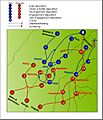Battle of the Catalaunian Plains facts for kids
The Battle of the Catalaunian Plains was a huge and important battle that happened in 451 AD. It's also known as the Battle of Châlons-sur-Marne or Battle of Châlons. This epic clash took place in a region called Gaul, which is now France.
In this battle, the powerful Roman army, led by a brilliant general named Flavius Aetius, teamed up with brave Visigoth warriors. Their leader was Theodoric I. Together, they faced off against the fearsome Attila the Hun and his mighty army. Attila's forces were mostly horsemen, known for their speed and skill.
The battle was incredibly fierce and ended in a 'stalemate'. This means neither side completely won, but Attila's army suffered so many losses that they couldn't keep attacking. This was a big victory for the Roman and Visigoth alliance. The Battle of the Catalaunian Plains stopped Attila's big plans to conquer the Roman Empire. It also marked the beginning of the end for his empire in Europe. However, this battle also weakened the already struggling Western Roman Empire, which eventually collapsed about 25 years later in 476 AD.
Contents
Who Were the Main Leaders?
Meet Flavius Aetius, the Roman General
Flavius Aetius was a very important Roman general. He was often called "the last of the Romans" because he was one of the last great military leaders of the Western Roman Empire. Aetius had a lot of experience fighting different groups, including the Huns themselves. He even spent time living with the Huns when he was younger, which helped him understand their ways of fighting.
Aetius was known for his clever strategies and his ability to make alliances. He knew that the Roman Empire was not strong enough to fight Attila alone. That's why he worked hard to bring together different groups, like the Visigoths, to stand against the Huns. His leadership was key to stopping Attila's invasion.
Attila the Hun: The Scourge of God
Attila the Hun was one of the most feared leaders in history. He led the Huns, a group of nomadic warriors from Central Asia. Attila was known for his brutal attacks and his desire to expand his empire. People often called him "the Scourge of God" because he brought so much destruction wherever he went.
Attila's army was made up mostly of skilled horsemen. They were incredibly fast and used bows and arrows with great accuracy. Before the Battle of the Catalaunian Plains, Attila had already attacked many parts of Europe, including Gaul. He believed he could conquer the entire Roman Empire.
Theodoric I: King of the Visigoths
Theodoric I was the king of the Visigoths, a powerful Germanic people who had settled in Gaul. The Visigoths were skilled warriors, and their alliance with the Romans was crucial for the battle. Even though the Romans and Visigoths had fought each other in the past, they knew they had to unite to defeat the common enemy: Attila.
King Theodoric I led his Visigoth warriors bravely in the battle. Sadly, he died during the fighting, becoming a hero who gave his life to protect his people and stop Attila. His sacrifice showed how serious the threat from the Huns was.
Why Was This Battle So Important?
Stopping Attila's Invasion
The Battle of the Catalaunian Plains was a turning point in history. Before this battle, Attila seemed unstoppable. He had conquered many lands and spread fear across Europe. His goal was to invade and take over the wealthy Roman Empire.
By stopping Attila in Gaul, the Roman and Visigoth alliance prevented him from marching further into the heart of the empire. If Attila had won, the history of Europe might have been very different. This battle saved many cities and regions from destruction.
The End of the Hunnic Empire
Even though the battle was a stalemate, it was a major defeat for Attila. His army suffered huge losses, and he couldn't continue his invasion. After this battle, Attila's power began to fade. He died just a year later, and his vast Hunnic empire quickly fell apart. The Battle of the Catalaunian Plains marked the end of the Huns as a major threat in Europe.
Impact on the Roman Empire
While the battle was a victory for the West, it also showed how weak the Western Roman Empire had become. The Romans needed the help of other groups like the Visigoths to defend themselves. This battle used up a lot of the Roman Empire's remaining strength and resources. Just 25 years later, in 476 AD, the Western Roman Empire officially collapsed. The Battle of the Catalaunian Plains was one of the last major military victories for the Roman Empire before its fall.
Images for kids
See also
 In Spanish: Batalla de los Campos Cataláunicos para niños
In Spanish: Batalla de los Campos Cataláunicos para niños


